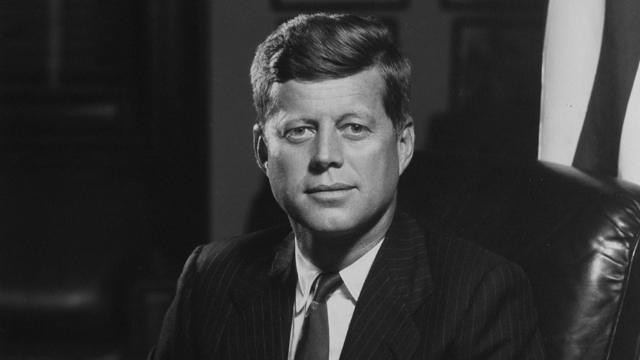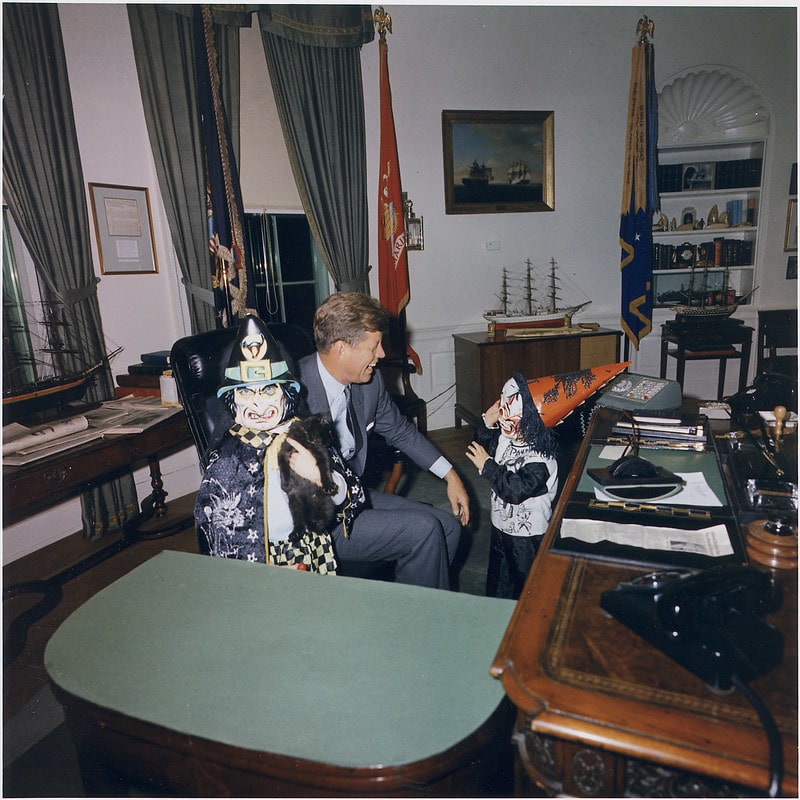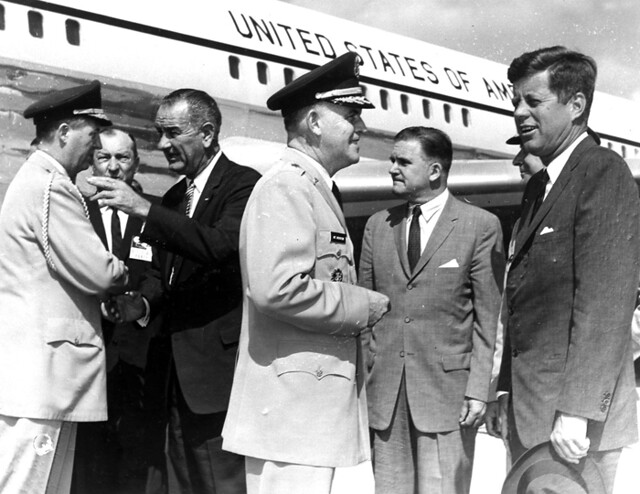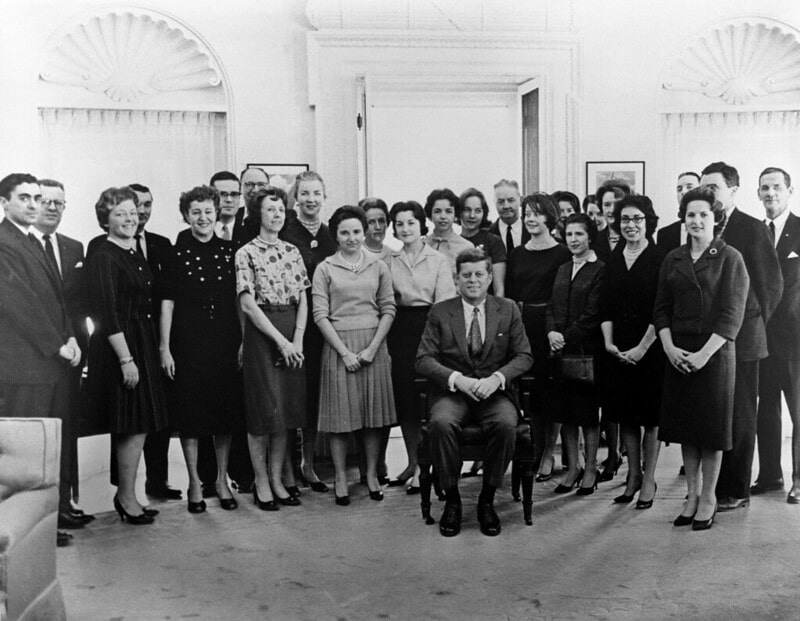Last updated on February 7th, 2023
John Fitzgerald Kennedy, the 35th president of the United States of America, was born in a wealthy and influential family. Before becoming the president, he served in both the U.S. House of Representatives and U.S. Senate. John’s father, Joseph Kennedy Sr., from a very young age, wanted to instill in his children a habit of outperforming their competition in every respect of life. It is said that the future president of the U.S. bought into his father’s philosophy that winning was everything. With these interesting facts about John F. Kennedy, let us learn more about his political and personal life.
Early Life, Family, Education
1. John Fitzgerald Kennedy, who would later come to be known universally as JFK, was born at Brookline, Massachusetts, on May 29, 1917, to Joseph Patrick Kennedy Sr. and Rose Elizabeth Kennedy. He had many siblings, including Senator Ted Kennedy, Senator Robert F. Kennedy, and Special Olympics founder Eunice Kennedy Shriver.
2. John F. Kennedy was the second child out of nine. They all went on to have significant political, social, and historical significance.

3. He was quite sick throughout his childhood with various, sometimes life-threatening, illnesses. His mother recorded in her notes that he suffered from measles, chickenpox, and whooping cough. On February 20, 1920, when he was almost three years old, John contracted scarlet fever.
4. While in high school Kennedy was a right-handed baseball pitcher and third baseman. Later on in his life, he would be responsible for throwing the opening pitch on April 8, 1963, for the Washington Senators during their game against the Baltimore Orioles.
5. John Kennedy graduated from Harvard in 1940.
6. He was a very sick child and remained sick throughout his entire life though this was kept secret to keep it from affecting his political career. His medical issues were mostly painful, and he had many medical specialists he regularly saw as president though this was kept from the public.
7. He entered the United States Navy. When the boat he was stationed on was sunk by a Japanese destroyer vessel in 1943, he was severely injured but was still able to save a badly burned sailor. For this, he received the U.S. Navy and Marine Corps Medal. He and many others who survived, spent the following several days on an island. Here Kennedy used a coconut shell to send a message for help. This shell he later kept on his desk in the Oval Office.

Early Career, Military Service, Marriage, Run for Presidency
8. John F. Kennedy was awarded the following medals for his time in the navy: Navy and Marine Corps Medal, Purple Heart Medal, American Defense Service Medal, American Campaign Medal (LST-449 P19-1), Asiatic-Pacific Campaign Medal (with 3 bronze stars) (PT-59 P24-4), and the World War II Victory Medal PT-109 P21-1.
9. He was discharged in 1945, but during his time in the Navy, he suffered from a significant back injury that aggravated his Addison’s disease – a chronic illness involving adrenal insufficiency. He had spinal fusion surgery in 1954 and dealt with extreme chronic pain for the rest of his life.
10. One coping mechanism for dealing with Addison disease was amphetamines injections. At that time in history, the adverse side effects were not fully understood, so this was a fairly common practice. Both he and his wife were both dependent on amphetamines by the time of the presidency.
11. At twenty-nine years old, he won the 1946 election when he ran for Congress and served the House of Representatives from 1947 to 1953 as a liberal. He focused on social services, higher wages, more affordable rent, better working conditions, and he was a supporter of Cold War policies.
12. John F. Kennedy married Jacqueline Lee Bouvier on September 12, 1953, at St. Mary’s Roman Catholic Church in Newport, Rhode Island. Jacqueline “Jackie” Kennedy was from a distinguished family and well-loved by the public. She helped to boost John’s run for a position with the U.S. Senate.
13. He co-wrote the 1956 Pulitzer Prize-winning book “Profiles in Courage” with his assistant Theodore Sorensen. The book contained the history and significant events of eight American political leaders.
14. John F. Kennedy lost the open battle for the vice-presidential nomination at the 1956 Democratic National Convention. He lost the vice presidential nomination to Estes Kefauver.
15. George Washington, Zachary Taylor, Dwight D. Eisenhower, James A. Garfield, Woodrow Wilson and Donald Trump are the only six presidents of the United States of America that contested an election and never lost it.
16. By 1956 he was the most well known political figure in the American political landscape. Both John and Jackie took part in many magazine photo shoots, which also helped his popularity. His 1958 run for Senate re-election garnered him the most significant win in Massachusetts history, with 874,608 votes.
17. John and Jackie Kennedy would go on to have three children, Caroline Kennedy, John F. Kennedy Jr., and Patrick Bouvier Kennedy. Patrick died on his second day of Hyaline Membrane Disease and was buried at Arlington National Cemetery. They also had a stillbirth, Arabella, in 1956.
18. John F. Kennedy announced his run for the presidency in January of 1960 as a Democratic. His running mate was Lyndon B. Johnson of Texas. Lyndon would become the 36th president of the United States and be in the office from 1963 to 1969 after the infamous assassination of JFK.

19. The song used by John Kennedy’s campaign for the presidency was an altered version of “High Hopes” which had lyrics changed to support Kennedy. It was sung and recorded by the legendary Frank Sinatra. They were briefly very close friends though it did not last.
Presidency
20. Kennedy won the presidency on November 8, 1960, at the age of 43 to become the 35th president of the United States. He was the youngest to become president after having been elected. He was also the very first Roman Catholic elected to the presidency. The youngest person to assume the presidency was Theodore Roosevelt, who succeeded to the office at the age of 42 years, 322 days after the assassination of William McKinley.
21. He was the first person to ever dance with African American women at an inaugural ball. Equality was something he would focus on throughout his entire term as president.
22. Kennedy was an avid smoker of cigars, favoring Upmanns or Monticellos and often consuming four or five a day. Directly before signing the Trade Embargo which would make importing Cuban cigars illegal, John F. Kennedy ordered a staggering 1,200 of them for the White House.

23. He gave the entirety of his $100,000 a year presidential salary to charity. Interestingly, when he took office he was the richest man ever to do so. At the time his family fortune was approximately valued at $1 billion.
24. During his time as president, Kennedy invited several dozen African leaders to the White House. He was an avid supporter of African nationalism, independence, anti-colonialism, and self-determination. His attempts were reduced by the presence of the Cold War and the Soviet Union’s interest in the Congo.
25. The arts were essential to the Kennedy family and the presidency. John Kennedy created the position of Special Consultant on the Arts in 1962. He was also specifically interested in creating an artistic approach to architecture in the United States, and the General Services Administration Art in Architecture Program was created.
26. He was a speed reader and went to events at the Foundation for Better Reading in Baltimore in 1954 and 1955. Kennedy was capable of reading at an amazing 1,200 words per minute. For context, the average American adult can read about 200 to 250 words per minute.
Martin Luther King Jr., Veitnam War, Nuclear Test Ban Treaty, Civil Rights Act
27. The 1960s was a time in civil rights-focused on equality. In August of 1963, more than 200,000 Americans marched for equality. This was the moment of Martin Luther King Jr.’s “I Have a Dream” speech. Kennedy created the President’s Committee on Equal Employment Opportunity and supported desegregation.
28. The space race started before his presidency, but Kennedy worked to secure funding for space programs with the goal of sending an American to the moon first in the space race against the Soviet Union. Kennedy would be assassinated before being able to see it come to fruition.

29. President Kennedy was in office during the Cold War when tensions between the Soviet Union were high. The Bay of Pigs, Cuban Missile Crisis, and the Vietnam war were all historical events under his presidency. Towards the end of his administration, there was finally a weakening of the Cold War.
30. President Eisenhower had supported Latin American military dictators in areas like Paraguay, Peru, and Venezuela. Kennedy worked to show his support of the Latin American people and their right and peaceful economic growth. He created the Alliance for Progress and dedicated over $20 billion to Latin American nations in 1961.
31. The Bay of Pigs was a failed operation approved by President Kennedy in 1961, during which the CIA trained Cuban exiles for a landing operation against Fidel Castro’s administration. Almost 1,400 American-trained Cubans were used for a full scale invasion of Cuba by the Kennedy administration. The move to remove Fidel Castro from power failed when his troops outnumbered the invaders. To minimize the cost of this failure, Kennedy also approved Operation Mongoose, which was meant to destabilize the Cuban government.
32. In mid-1992, the Soviet leader chose to focus on whatever resources were necessary to upgrade their nuclear arsenal. This choice escalated the already competitive arms race between the United States and the Soviet Union. In 1963 the Limited Nuclear Test Ban Treaty was signed.
33. Between 1961 to 1963, John F. Kennedy approved the sending tens of thousands of American soldiers to Vietnam to help the South Vietnam government in their war. This was a contentious decision, and there were demonstrations and riots from anti-war groups. Kennedy was assassinated while still trying to determine if American soldiers should be recalled or not.
34. On the night of August 12-13, 1961, East German soldiers laid down more than 30 miles of barbed wire barrier through the heart of Berlin. Within 24 hours, it was illegal to move freely across the wall. The wall was erected to stop the mass exodus of people fleeing Soviet East Berlin for West Berlin and the non-Communist world. Kennedy visited Berlin two years later in which he publicly spoke out against the oppression. The area where he made the speech was renamed the John F. Kennedy Platz.
35. Kennedy intended to be the first American president to visit Japan, but he was assassinated before his trip could take place. However, to pre-empt his visit, he sent his brother, Attorney General Robert F. Kennedy, to Tokyo in 1962, where he succeeded in creating a positive impact on the country.
36. During her husband’s presidency, Jackie Kennedy created many positive changes within the social and political landscapes of America. One of the projects that she oversaw was the restoration of the White House and worked to make it comfortable, and a symbol of whichever person became the sitting president.
37. President Kennedy installed the tape recording system in the White House. The Senate Watergate Committee would use tapes from this. Kennedy had the system created to present an accurate record of discussions in the White House. He also intended to make use of the tapes when he wrote the memoir of his years in office, unfortunately a book that he never had a chance to write.
38. John Kennedy proposed the Civil Rights Act, which took effect in 1964 after his death. This was the evolution of the most comprehensive rights at the time and contained, among other things, the outlawing of discriminatory practices against women and African Americans which outlawed segregation in businesses such as theaters, restaurants, and hotels. The act also banned discriminatory practices in employment and ended segregation in public places such as swimming pools, libraries, and public schools.
39. In an attempt to match the dedication of the Soviet Union public to join organizations abroad, Kennedy suggested the creation of the Peace Corps. This was put into effect on March 1, 1961, with Africa being the first continent visited. The president met the first volunteers on August 28, 1961.
His assassination
40. One of the most famous moments in United States history is the assassination of John F. Kennedy. He died of a gunshot on the neck and the head on November 22, 1963, while he and his wife were part of a motorcade in Dallas, Texas. The car the Kennedy’s were in, sped off to Parkland Memorial Hospital just a few minutes away. However, the damage was already done and the beloved president had passed away. At 1:00 p.m. John F. Kennedy was pronounced dead.

41. His alleged killer was Lee Harvey Oswald, who was arrested and shot dead himself while in police custody two days later by Jack Ruby. Lee Harvey Oswald’s assassination is considered one of the most public murders in history due to a large number of people physically present and the live broadcasting of the event on television.
42. Jack Ruby, a Dallas nightclub owner who shot Lee Harvey Oswald, was sentenced to death for his crime though this was later overturned. The moment he shot Oswald had been recorded as live television crews had been on hand to show the transfer of the president’s assassin.
43. The president’s body was buried on November 25, 1963, in Arlington National Cemetery. Attendants to the funeral included heads of state from over one hundred different countries while millions of people watched the service on television. Iconic images of his family were taken at his graveside.

44. The new President Lyndon Johnson created a commission on November 29, 1963, to look into the death. The investigation into who assassinated John F. Kennedy was headed by Earl Warren, Chief Justice of the United States, in what would become known as the Warren Commission.
45. The investigation into JFK’s assassination ended up being compiled into an 888-page document, and they determined that Lee Harvey Oswald acted alone without outside influence and without partners. All of the records of the Warren Commission are now available online for the public to view.
46. Lee Harvey Oswald was responsible for the murder and attempted murder of multiple other people, including the attempted assassination on April 10, 1963, of retired Major General Edwin Walker. He also wounded Texas Governor John B. Connally in the same shooting that killed Kennedy.
47. There are hundreds of memorials to John F. Kennedy in dozens of countries around the world, and he is still considered one of America’s most popular presidents.
. . . continue reading on the next page (inspirational quoted by JFK)
